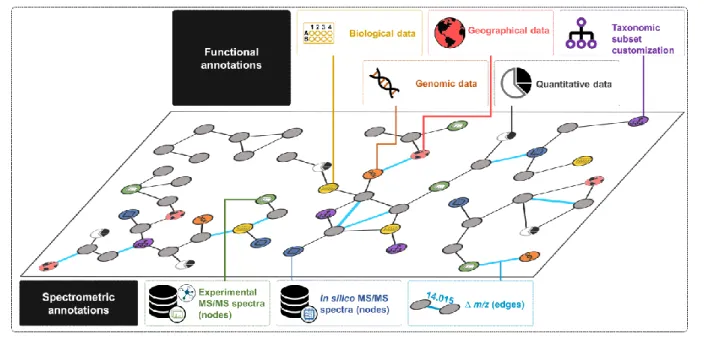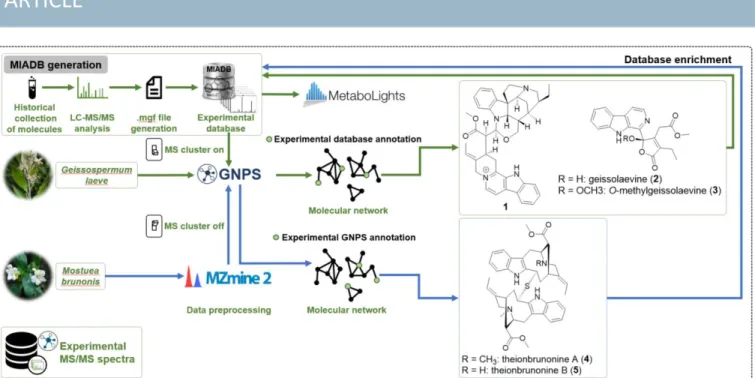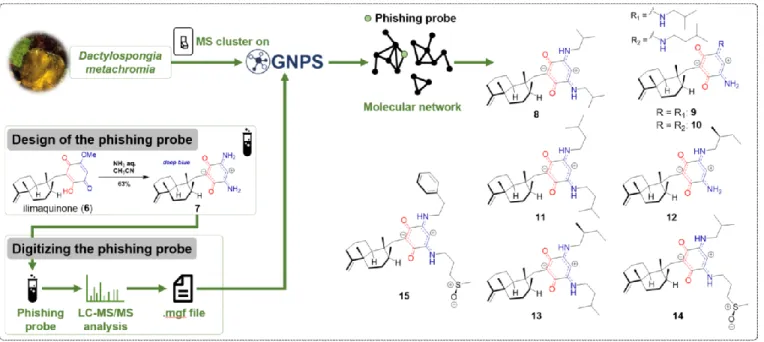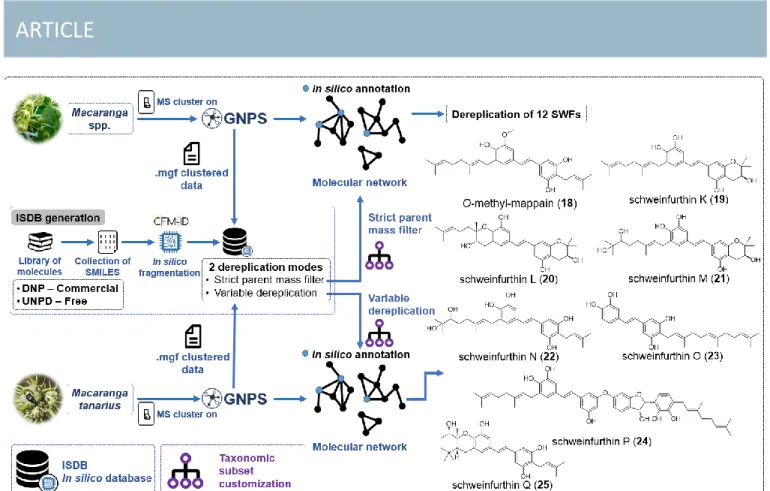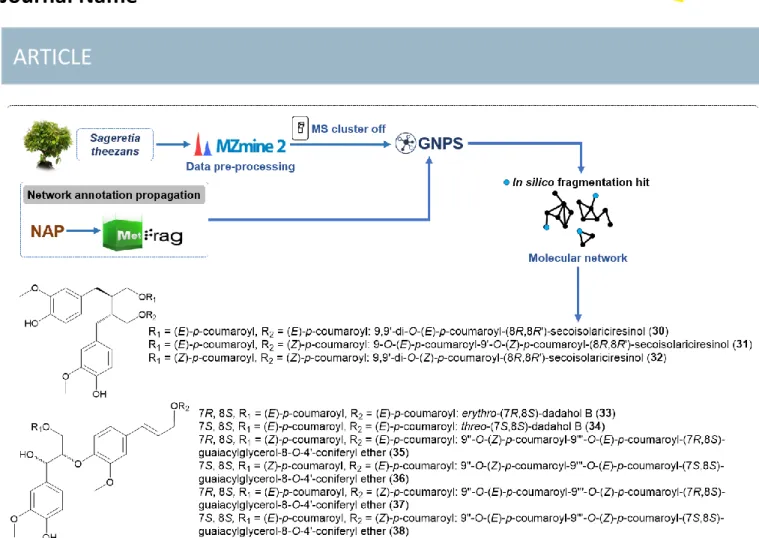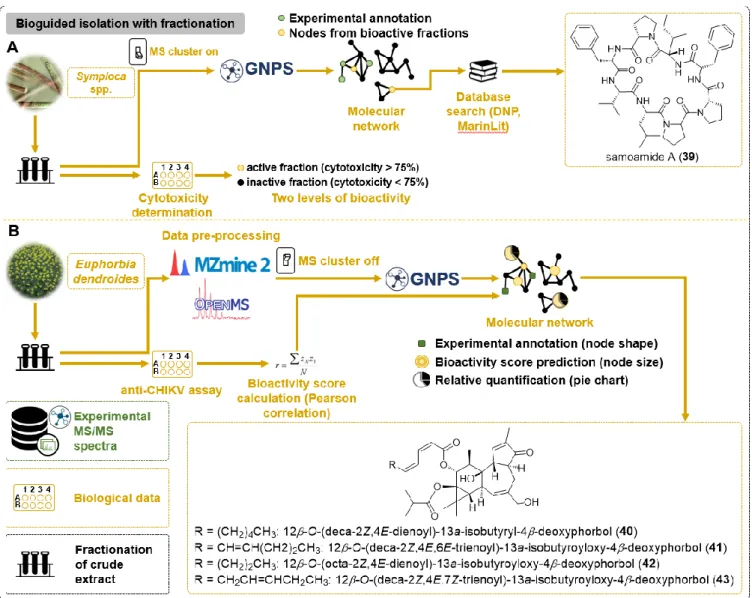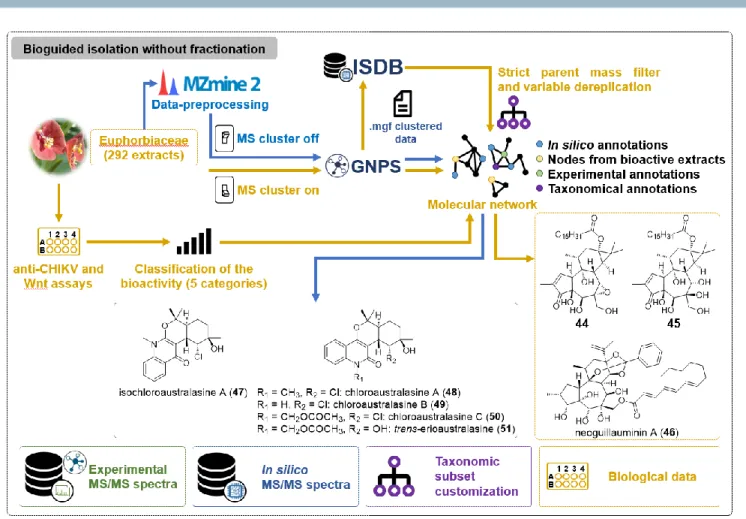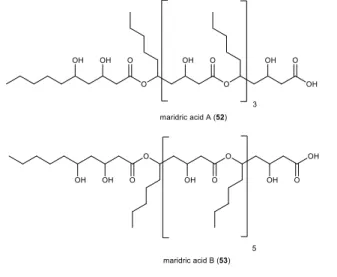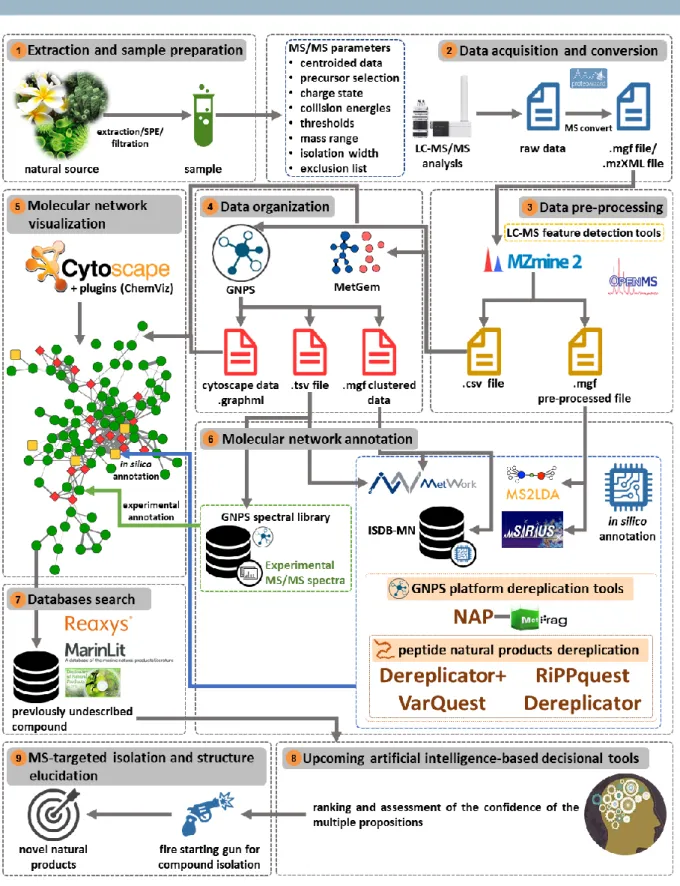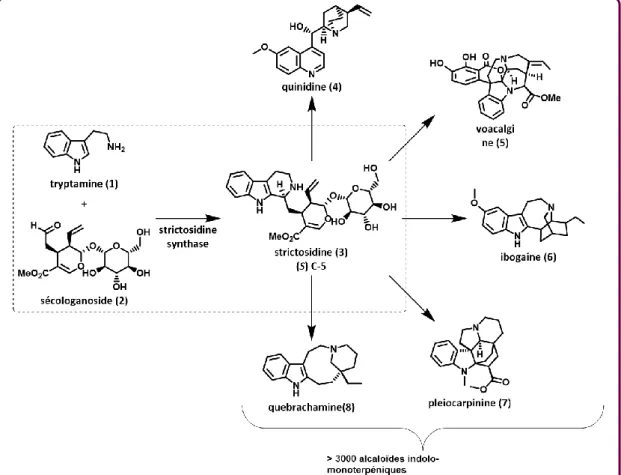HAL Id: tel-02221740
https://tel.archives-ouvertes.fr/tel-02221740
Submitted on 1 Aug 2019
HAL is a multi-disciplinary open access
archive for the deposit and dissemination of
sci-entific research documents, whether they are
pub-lished or not. The documents may come from
teaching and research institutions in France or
abroad, or from public or private research centers.
L’archive ouverte pluridisciplinaire HAL, est
destinée au dépôt et à la diffusion de documents
scientifiques de niveau recherche, publiés ou non,
émanant des établissements d’enseignement et de
recherche français ou étrangers, des laboratoires
publics ou privés.
Exploration de la diversité chimique des Apocynaceae
par la technique des réseaux moléculaires : de la création
d’une base de données vers l’annotation in silico
Alexander Fox Ramos
To cite this version:
Alexander Fox Ramos. Exploration de la diversité chimique des Apocynaceae par la technique des
réseaux moléculaires : de la création d’une base de données vers l’annotation in silico. Chimie
thérapeu-tique. Université Paris-Saclay, 2018. Français. �NNT : 2018SACLS543�. �tel-02221740�
Exploration de la diversité chimique
des Apocynaceae par la technique
des réseaux moléculaires : de la
création d’une base de données
vers l’annotation in silico
Thèse de doctorat de l'Université Paris-Saclay
préparée à l’Université Paris-Sud
École doctorale n°569 Innovation thérapeutique, du fondamental à
l’appliqué
Spécialité de doctorat : Chimie des substances naturelles
Thèse présentée et soutenue à Châtenay-Malabry, le 21 Décembre 2018, par
Alexander Enrique FOX RAMOS
Composition du Jury :M. Pascal Richomme-Peniguel
Professeur, Université d’Angers (EA 921 SONAS) Président du jury
Mme. Soizic Prado
Professeur, MNHM (UMR CNRS 7245) Rapportrice
M. Marc Litaudon
Ingénieur de recherche, ICSN (UPR CNRS 2301) Examinateur
Mme. Catherine Roullier
Maître de conférences, Université de Nantes (EA 2160 MMS) Examinatrice M. Mehdi Beniddir
Maître de conférences, Fac. Pharma. Châtenay (BioCIS - UMR 8076) Examinateur M. Pierre Champy
Professeur, Fac. Pharma. Châtenay (BioCIS - UMR 8076) Directeur de thèse
NNT
:
2
0
1
8
S
A
CL
S
5
4
3
Université Paris-Saclay
Espace Technologique / Immeuble Discovery
Route de l’Orme aux Merisiers RD 128 / 91190 Saint-Aubin, France
3
Je remercie sincèrement le Pr. Pascal Richomme-Peniguel et la Pr. Soizic Prado
d’avoir accepté d’être les rapporteurs de cette thèse ainsi que le Dr. Marc Litaudon et le Dr.
Catherine Roullier de participer au jury en tant qu’examinateurs. Merci de me faire
l’honneur de juger ce travail.
Je voudrais remercier le Prof. Pierre Champy. Son intérêt envers l’utilisation
traditionnelle des plantes, ainsi que son savoir polymathique sur la taxonomie végétale est
passionnante. Je lui remercie de m’avoir reçu en tant que stagiaire de M1 et d’avoir encadré
cette thèse pendant ces trois ans. Je lui adresse ici toute ma reconnaissance et mon amitié.
Je souhaite ensuite adresser mes remerciements les plus amicaux au Dr. Mehdi A.
Beniddir, co-encadrant de cette thèse et examinateur dans le jury. Depuis mon stage de M1,
l’apprentissage de nouvelles façons de « faire de la science » ne s’est pas arrêté grâce à lui.
Des discussions jusqu’à très tard au laboratoire, des précieux conseils dans le plan
professionnel et personnel, ainsi que des réussites célébrées et des défaites surmontées le
long de ces trois ans. Tous ces moments partagés resteront toujours dans ma mémoire.
Je voudrais également remercier le Docteur Bruno Figadère, directeur de l’UMR et
du laboratoire, qui m’a permis de réaliser ces travaux au sein de l’équipe « chimie des
substances naturelles » de BioCIS.
D’autre part, j’adresse mes remerciements à mes collègues du laboratoire que j’ai eu
le plaisir de côtoyer, aux stagiaires que j’ai eu l’opportunité d’encadrer ainsi qu’aux
enseignants de l’équipe qui m’ont beaucoup appris le long de ces trois ans et pendant le M2
également. Je pense ici particulièrement au Prof. Erwan Poupon, Prof. Michel Lebœuf, Dr.
François Roblot, Dr. Alexandre Maciuk, Dr. Laurent Evanno, Dr. Christophe Fourneau, Dr.
Natacha Bonneau, Pedro Vasquez, Gaëla Cauchie, Coralie Pavesi, Florian Maloberti, Chloé
Vetel et Mohamed Belemlilga.
Je voudrais également remercier le Dr. Guillaume Bernadat (équipe Chimie des
Substances Naturelles, BioCIS) pour les cours de modélisation moléculaire sur Python et la
réalisation des simulations des spectres de dichroïsme circulaire électronique des produits
isolés.
Par ailleurs, je remercie sincèrement Blandine Séon-Méniel (équipe Chimie des
Substances Naturelles, BioCIS) pour la préparation des micro-tubes des composés isolés
pour réaliser les analyses RMN.
Université Paris-Saclay
Espace Technologique / Immeuble Discovery
Route de l’Orme aux Merisiers RD 128 / 91190 Saint-Aubin, France
4
Je tiens à remercier également Karine Leblanc (service chromatographie,
spectrométrie de masse, BioCIS) pour toute son aide dans la détermination des conditions
analytiques pour la purification des molécules ciblées et pour les analyses des échantillons
sur le CLHP-Q-TOF.
Je voudrais également adresser mes remerciements à M. Jean-Christophe Jullian,
responsable du service RMN de BioCIS, et Mme. Camille Dejean, d’avoir effectué les
analyses RMN des composés purifiés.
J’adresse également mes remerciements à Mme. Elisabeth Mouray et au Pr. Phillippe
Grellier de l’Unité de Molécules de Communication et Adaptation des Micro-organismes
(MCAM) du Muséum National d’Histoire Naturelle (MNHN) pour la détermination de
l’activité antipaludique de molécules isolées.
Je tiens à remercier le Dr. Phillipe M. Loiseau et le Dr. Sébastien Pomel de l’équipe de
chimiothérapie antiparasitaire de BioCIS d’avoir effectué les tests d’activité
antileishmanienne des composés purs.
De plus, je remercie le Dr. Christophe Duplais, du laboratoire EcoFog (CNRS, UMR
8172) en Guyane d’avoir effectué la récolte du matériel végétal pour entreprendre l’étude
phytochimique des écorces de Geissospermum laeve (Vell.) Miers.
Je remercie également le Dr. Marc Litaudon, de l’ICSN, pour avoir mis à notre
disposition les Astonia qu’il a récoltés en Nouvelle-Calédonie avec le Dr. Vincent Dumontet.
Je souhaite remercier M. Jean-François Gallard, responsable du service RMN à
l’Institut de Chimie de Substances Naturelles (ICSN - UPR CNRS 2301), d’avoir consacré du
temps pour la réalisation des analyses RMN des molécules isolées.
Un grand merci à FONDECYT (Fondo Nacional de Desarrollo Científico y Tecnológico)
– CONCYTEC (Consejo Nacional de Ciencia, Tecnología e Innovación Tecnologica) pour
m’avoir permis de réaliser mes études de doctorat grâce au financement de ma thèse
pendant ces trois ans.
Je souhaite également remercier ma belle-famille, particulièrement Virginie et
Jacques mais également Francis et Raymonde pour leur immense gentillesse et leur accueil
chaleureux.
Je remercie de tout mon cœur mes parents, qui ont su m’encourager et me soutenir
malgré la distance physique qui nous sépare.
Université Paris-Saclay
Espace Technologique / Immeuble Discovery
Route de l’Orme aux Merisiers RD 128 / 91190 Saint-Aubin, France
5
Enfin, je remercie ma femme, Charlotte Fox-Alcover, pour ses encouragements, sa
patience son soutien et son amour au cours de ces trois ans. Cette aventure scientifique
n’aurait pas pu être possible sans toi. Ce travail lui est dédié.
Université Paris-Saclay
Espace Technologique / Immeuble Discovery
Route de l’Orme aux Merisiers RD 128 / 91190 Saint-Aubin, France
Université Paris-Saclay
Espace Technologique / Immeuble Discovery
Route de l’Orme aux Merisiers RD 128 / 91190 Saint-Aubin, France
7
Remerciements ... 3
Table de matières ... 7
Préambule ... 9
Liste des abréviations ... 11
Liste des images ... 12
Liste des tableaux ... 13
Introduction générale : L’art de l’isolement de produits naturels dans l’ère du Big Data .. 17
Chapitre I : Stratégies d’application du molecular networking pour l’isolement de produits
naturels ... 21
1.
Introduction ... 21
1.1
Approche par molecular networking : description générale... 21
1.2
Traitement des données ... 22
1.3
Bases de données utilisées comme référence ... 22
1.4
Types de stratégie appliqués ... 23
1.5
Outils et stratégie visant à améliorer la pratique du molecular networking ... 23
2.
Publication associée ... 27
Chapitre II : Conception d’une base de données d’alcaloïdes indolomonoterpéniques : la
MIADB ... 53
1.
Introduction ... 53
1.1
Description générale... 53
1.2
Biogenèse et classification... 54
1.3
Biogenèse ... 56
1.4
MIADB (Monoterpene Indole Alkaloids DataBase) : du concept à l’application ... 59
2.
Publication associée ... 69
Chapitre III : Première application de la MIADB – Exploration de l’espace chimique de
Geissospermum laeve (Vell.) Miers. ... 113
1.
Introduction ... 113
1.1
Phylogénie et description botanique ... 113
1.2
Répartition géographique ... 114
1.3
Geissospermum laeve (Vell.) Miers ... 114
2.
Publication associée ... 119
3.
Résultats obtenus après publication ... 171
T
ABLE DE MATIÈRES
Université Paris-Saclay
Espace Technologique / Immeuble Discovery
Route de l’Orme aux Merisiers RD 128 / 91190 Saint-Aubin, France
8
Chapitre IV : Deuxième application de la MIADB – Exploration de l’espace chimique
d’Alstonia balansae ... 175
1.
Introduction ... 175
1.1
Phylogénie et description botanique ... 175
1.2
Répartition géographique ... 176
1.3
Alstonia balansae Guillaumin ... 176
1.4
Travaux entrepris sur Alstonia spp. ... 178
2.
Publication associée ... 183
3.
Résultats biologiques obtenus ... 250
Conclusion générale ... 253
Perspectives ... 255
Bilan des communications ... 259
Université Paris-Saclay
Espace Technologique / Immeuble Discovery
Route de l’Orme aux Merisiers RD 128 / 91190 Saint-Aubin, France
9
Ce manuscrit a été rédigé sous la forme d’une « thèse sur article ». Il est composé de
quatre chapitres chacun présentant un article scientifique publié ou à soumettre à l’issue
des travaux de recherche entrepris. Les publications originales en langue anglaise ont été
incluses avec un résumé en langue française présenté au préalable.
Dans le premier chapitre, les stratégies actuelles d’application du molecular networking
(technique des réseaux moléculaires) pour l’identification et l’isolement de nouveaux
produits naturels seront abordées. Une description générale des approches de déréplication
reposant sur cette innovation sera réalisée. En outre, les différentes étapes clés concernant
l’utilisation de cet outil seront développées.
Le deuxième chapitre est consacré à décrire la conception d’une base de données
d’alcaloïdes indolomonoterpéniques (AIMs) au sein de notre laboratoire, avec les apports de
plusieurs laboratoires de pharmacognosie : la MIADB (Monoterpene Indole Alkaloids
DataBase). Une description générale des AIMs sera montrée, ainsi que leur origine
biosynthétique, en introduction.
Les deux chapitres suivants correspondent à des applications de cette méthodologie, avec
l’étude chimique et l’isolement de nouveaux AIMs à partir d’Apocynaceae. Les espèces
étudiées seront présentées. Les articles correspondants seront ensuite proposés.
Le troisième chapitre, dédié à une première application de la MIADB, décrit l’exploration de
l’espace chimique des écorces de Geissospermum laeve (Vell.) Miers.
Finalement, un quatrième chapitre mènera à une nouvelle approche de déréplication :
l’utilisation du molecular networking avec une annotation in silico par MetWork.
L’application de cette méthode pour l’exploration de la diversité chimique des feuilles
d’Alstonia balansae Guillaumin.
Enfin, une conclusion générale est présentée, ainsi que les perspectives envisageables après
ces travaux.
Université Paris-Saclay
Espace Technologique / Immeuble Discovery
Route de l’Orme aux Merisiers RD 128 / 91190 Saint-Aubin, France
Université Paris-Saclay
Espace Technologique / Immeuble Discovery
Route de l’Orme aux Merisiers RD 128 / 91190 Saint-Aubin, France
11
L
ISTE DES ABRÉVIATIONS
AIM : alcaloïde indolomonoterpénique
APG : Angiosperm Phylogeny Group
CI
50: concentration inhibitrice médiane
CLHP : chromatographie en phase liquide à haute performance
COSY : « correlation spectroscopy »
DCE (ECD) : dichroïsme circulaire électronique (« electronic circular dichroism »)
DMEM : « Dulbecco's modified Eagle's medium » (milieu de culture d’Eagle modifié par
Dulbecco)
DMSO : diméthylsulfoxyde
ESI : ionisation par électronébuliseur
FCS : « fetal calf serum » (sérum de veau fœtal)
GNPS : « Global Natural Products Social molecular networking »
HMBC : « heteronuclear multiple bond correlation »
HSQC : « heteronuclear single quantum correlation »
ICSN : Institut de Chimie des Substances Naturelles
MIADB : « Monoterpene Indole Alkaloids DataBase » (base de données d’alcaloïdes
indolomonoterpéniques)
MN : « molecular networking » (technique des réseaux moléculaires)
MNHN : Muséum national d’Histoire naturelle
MTS :
3-(4,5-dimethylthiazol-2-yl)-5-(3-carboxymethoxyphenyl)-2-(4-sulfophenyl)-2H-tetrazolium
m/z : rapport masse sur charge d’un ion
NOESY : « nuclear overhauser effect spectroscopy »
Q : quadrupôles
Q-ToF : spectromètre de masse tandem quadripôle-temps de vol
RMN : résonnance magnétique nucléaire
RPMI : « Roswell Park Memorial Institute medium » (milieu de culture du Roswell Park
Memorial)
RT : « retention time » (temps de rétention)
SM : spectrométrie de masse
SMHR : spectrométrie de masse haute résolution
SM/SM : spectrométrie de masse en tandem
VIH : virus de l’immunodéficience humaine
Université Paris-Saclay
Espace Technologique / Immeuble Discovery
Route de l’Orme aux Merisiers RD 128 / 91190 Saint-Aubin, France
12
L
ISTE DES IMAGES
Figure 1.
Quelques Gentianales et un exemple d’alcaloïde indolomonoterpénique ... 53
Figure 2.
Biosynthèse des alcaloïdes indolomonoterpéniques à partir de la strictosidine .... 55
Figure 3.
Classification des alcaloïdes indolomonoterpéniques d’après Le Men et Taylor
(1965) ... 56
Figure 4.
Schéma de filiation biogénétique des AIMs monomériques. ... 58
Figure 5.
Bisindoles majoritaires de G. laeve ... 59
Figure 6.
Évolution de la MIADB au cours du temps ... 65
Figure 7.
Espèces du genre Geissospermum ... 113
Figure 8.
Répartition géographique des espèces du genre Geissospermum ... 114
Figure 9.
G. laeve dans l’herbier du Royal Botanical Gardens... 114
Figure 10.
Alcaloïdes indolomonoterpéniques décrits dans G. laeve ... 116
Figure 11.
Position de la région D dans le réseau moléculaire total ... 171
Figure 12.
Quelques espèces du genre Alstonia ... 175
Figure 13.
Répartition géographique des espèces du genre Alstonia ... 176
Figure 14.
A. balansae dans l’herbier du Royal Botanical Gardens ... 176
Université Paris-Saclay
Espace Technologique / Immeuble Discovery
Route de l’Orme aux Merisiers RD 128 / 91190 Saint-Aubin, France
13
L
ISTE DES TABLEAUX
Tableau 1.
Liste de laboratoires qui ont contribué à la constitution de la MIADB ... 62
Tableau 2.
Alcaloïdes indolomonoterpéniques décrits dans G. laeve ... 115
Tableau 3.
Alcaloïdes indolomonoterpéniques décrits dans A. balansae ... 177
Tableau 4.
Valeurs de CI
50(μM) des activités antipaludiques et antileishmaniennes et
cytotoxiques des composés 1−5
a... 250
Université Paris-Saclay
Espace Technologique / Immeuble Discovery
Route de l’Orme aux Merisiers RD 128 / 91190 Saint-Aubin, France
Université Paris-Saclay
Espace Technologique / Immeuble Discovery
Route de l’Orme aux Merisiers RD 128 / 91190 Saint-Aubin, France
15
I
NTRODUCTION GÉNÉRALE
:
L’
ART DE L
’
ISOLEMENT DES
PRODUITS NATURELS DANS L
’
ÈRE
Université Paris-Saclay
Espace Technologique / Immeuble Discovery
Route de l’Orme aux Merisiers RD 128 / 91190 Saint-Aubin, France
Université Paris-Saclay
Espace Technologique / Immeuble Discovery
Route de l’Orme aux Merisiers RD 128 / 91190 Saint-Aubin, France
17
L’influence de l’ère du big data dans le monde a touché plusieurs aspects de nos
vies.
1Nos manières de vivre, de communiquer, de travailler et de réfléchir ont été
transformées par cette nouvelle vague où l’information de notre quotidien est numérisée.
Dans ce contexte, la façon de « faire de la science » de nos jours a aussi changé. Elle
est même complètement différente de celle d’il y a quelques années. Les expériences sur la
paillasse sont à présent complétées par des traitements informatiques des données. De
cette manière, les molécules que l’on connaissait seulement sous la forme de structures
dessinées sur un papier sont devenues aujourd’hui de l’information numérisée exploitable
par des méthodes modernes de traitement, interfacées avec les méthodes d’analyse.
Au cours de ces dernières années, la découverte de composés inédits dans des
extraits issus de plantes ou d’autres organismes vivants est devenue plus facile, en raison de
l’accès à des techniques plus sensibles d’analyse de mélanges complexes. L’image de
« trouver une aiguille dans une botte de foin » évoquait de manière précise la difficulté
existant dans l’art de l’isolement des produits naturels. Ainsi, l’influence du traitement de
données massives a bouleversé le processus d’isolement des substances naturelles. C’est
ainsi que des nouvelles techniques permettant une identification précoce des molécules à
structure inédite dans des mélanges complexes ont été ajoutées au portfolio des méthodes
utilisées par plusieurs équipes de recherche autour du monde.
2De plus, grâce au partage
des connaissances au moyen des réseaux du big data, des collaborations entre laboratoires
pour améliorer ces techniques ont été établies.
Parallèlement, ces collaborations ont mené à la création de bases de données qui
ont été mises à la disposition de toute la communauté scientifique.
3L’annotation des
composés déjà décrits est donc plus efficace, permettant d’identifier précocement les
molécules à cibler au cours de travaux d’exploration de la diversité chimique des mélanges
complexes.
Dans ce manuscrit, ces changements de paradigme seront illustrés, avec la
constitution d’une base de données issue de la collaboration entre plusieurs laboratoires
ayant un historique de recherche autour des alcaloïdes indolomonoterpéniques (AIMs) et
l’application d’une démarche de déréplication adaptée à l’étude phytochimique
d’Apocynaceae. Le plan suivi a été présenté en préambule.
1 S. John Walker, Int. J. Advert., 2014, 33, 181-183.
2 J. Hubert, J.-M. Nuzillard, et al., Phytochem Rev., 2017, 16, 55-95. 3 M. Wang, J. J. Carver, et al., Nat. Biotechnol., 2016, 34, 828.
I
NTRODUCTION GÉNÉRALE
:
L’
ART DE L
’
ISOLEMENT DE PRODUITS
NATURELS DANS L
’
ÈRE DU
B
IG
D
ATA
Université Paris-Saclay
Espace Technologique / Immeuble Discovery
Route de l’Orme aux Merisiers RD 128 / 91190 Saint-Aubin, France
Université Paris-Saclay
Espace Technologique / Immeuble Discovery
Route de l’Orme aux Merisiers RD 128 / 91190 Saint-Aubin, France
19
C
HAPITRE
I :
S
TRATÉGIES D
’
APPLICATION DU
MOLECULAR NETWORKING POUR
Université Paris-Saclay
Espace Technologique / Immeuble Discovery
Route de l’Orme aux Merisiers RD 128 / 91190 Saint-Aubin, France
Université Paris-Saclay
Espace Technologique / Immeuble Discovery
Route de l’Orme aux Merisiers RD 128 / 91190 Saint-Aubin, France
21
C
HAPITRE
I
:
S
TRATÉGIES D
’
APPLICATION DU MOLECULAR NETWORKING
POUR L
’
ISOLEMENT DE PRODUITS NATURELS
1. I
NTRODUCTION
1.1 Approche par molecular networking : description générale
Pour les chercheurs dans le domaine des produits naturels, deux outils au minimum
s’avèrent indispensables pour la caractérisation correcte de la structure de molécules : la
résonance magnétique nucléaire (RMN) et la spectrométrie de masse (SM). La RMN s’est
positionnée comme l’outil le plus important pour réaliser cette tâche. D’autre part, la SM a
longtemps servi à principalement fournir les formules brutes des composés isolés, à côté de
l’analyse élémentaire.
4Des approches nouvelles permettent maintenant de tenter des
déterminations structurales avec la SM seule, aux stéréochimies près.
5Dans le cadre de l’appréhension de la complexité moléculaire des mélanges
complexes, la SM s’est consolidée comme un outil de choix pour une annotation efficace de
produits naturels dans un mélange. En effet, cette technique est à l’heure actuelle
largement utilisée pour identifier de manière précoce des composés déjà connus, afin
d’éviter l’utilisation inutile de ressources pour les isoler.
2Cette façon de procéder est
connue sous le nom de « déréplication ».
Depuis son implémentation en ligne, la technique du molecular networking
6(réseaux
moléculaires) a largement facilité la visualisation et la façon de cibler des produits naturels
dans des mélanges complexes. Cette technique fondée sur la spectrométrie de masse,
permet une comparaison des spectres SM/SM des ions détectés provenant d’un échantillon
suite à une séparation chromatographique. Ensuite, un score de similarité (appelé
« cosine ») est calculé pour représenter l’analogie structurale entre chaque paire de
composés du mélange. Ainsi, cette technique permet d’organiser et de visualiser des
données SM/SM sous la forme d’une carte de similarité spectrale, mettant en lumière
l’existence de groupes spectraux ainsi que leurs degrés de similarité. L’outil disponible pour
les chercheurs – le logiciel Cytoscape et l’environnement de travail avec la base de données
collaborative GNPS
3, pour « Global Natural Product Social molecular networking » – ont été
mis en place par l’équipe de P. Dorrestein, de l’University of California à San Diego. Un outil
alternatif similaire est développé par l’ICSN-CNRS à Gif-sur-Yvette (disponible sur :
https://github.com/metgem).
74 N. B. Cech & K. Yu, LC GC N. Am., 2013, 31, 938-947. 5 D. Nikolić, Phytochem Lett., 2017, 21, 292-296.
6 J. Y. Yang, L. M. Sanchez, et al., J. Nat. Prod., 2013, 76, 1686-1699. 7 F. Olivon, N. Elie, et al., Anal. Chem., 2018.
Université Paris-Saclay
Espace Technologique / Immeuble Discovery
Route de l’Orme aux Merisiers RD 128 / 91190 Saint-Aubin, France
22
Depuis sa création, cette technique a été intégrée au « workflow » (flux de travail)
quotidien de déréplication de nombreuses équipes. En effet, la comparaison des spectres
d’un échantillon avec ceux de substances de référence permet l’annotation du réseau
moléculaire obtenu. On peut rapidement distinguer des molécules déjà décrites et dédier
les efforts d’isolement aux composés potentiellement nouveaux.
1.2 Traitement des données
Avant de soumettre les données de l’échantillon au site du GNPS, elles doivent être
prétraitées. Ceci a comme but de réduire l’information qui correspond au bruit de fond,
d’ôter les isotopes des massifs isotopiques, etc. Bien qu’il existe une large gamme de
logiciels permettant de réaliser ce traitement, l’outil le plus utilisé à l’heure actuelle est
MZmine 2.
8, 9Généralement, plusieurs paramètres de traitement différents doivent être
testés avec ce logiciel avant d’obtenir une collection de spectres SM/SM correcte de
l’échantillon analysé. Par ailleurs, d’autres outils peuvent être utilisés pour le traitement des
données SM/SM, comme MassHunter® (Agilent)
10ou OpenMS
11.
1.3 Bases de données utilisées comme référence
Dans l’optique de réaliser une déréplication efficace, les équipes de recherche
autour du monde ont créé des collections de spectres SM/SM pouvant être utilisées comme
référence. Deux types de base de données peuvent être employés :
• Des bases de données de spectres SM/SM générées in silico. Un exemple est celle
créée par Pierre-Marie Allard et al. en 2016,
12constituée à partir de 170602 produits
naturels issus du Dictionnary of Natural Products fragmentés in silico avec l’outil
CFM-ID (Competitive Fragmentation Modeling for Metabolite Identification,
disponible sur : http://cfmid.wishartlab.com/)
13. L’emploi de la fragmentation in
silico pour la déréplication tend à se populariser
14et sera exploitée dans le dernier
chapitre de ce manuscrit.
• Des bases de données de spectres SM/SM expérimentaux.
15,16Ce sont les bases de
données les plus répandues. Une grande quantité de ce genre de collections est
disponible sur le site du GNPS
(https://gnps.ucsd.edu/ProteoSAFe/static/gnps-splash.jsp). La base de données d’alcaloïdes indolomonoterpéniques constituée par
notre équipe depuis 2015 fait aussi partie de ces collections (voir chapitre II).
8 T. Pluskal, S. Castillo, et al., BMC Bioinform., 2010, 11, 395. 9 F. Olivon, G. Grelier, et al., Anal. Chem., 2017, 89, 7836-7840.
10 F. Olivon, F. Roussi, et al., Anal. Bioanal. Chem., 2017, 409, 5767-5778. 11 H. L. Röst, T. Sachsenberg, et al., Nat. Methods, 2016, 13, 741.
12 P.-M. Allard, T. Péresse, et al., Anal. Chem., 2016, 88, 3317-3323. 13 F. Allen, A. Pon, et al., Nucleic Acids Res., 2014, 42, W94-W99.
14 R. R. da Silva, M. Wang, et al., PLOS Comput. Biol., 2018, 14, e1006089. 15 D. Krug & R. Müller, Nat. Prod. Rep., 2014, 31, 768-783.
Université Paris-Saclay
Espace Technologique / Immeuble Discovery
Route de l’Orme aux Merisiers RD 128 / 91190 Saint-Aubin, France
23
1.4 Types de stratégie appliqués
L’information originale des réseaux moléculaires peut être complétée par d’autres
types de données. Cela peut être fait de deux manières :
• Intégration d’une information complémentaire au réseau moléculaire dans le but de
cibler d’une manière plus spécifique des molécules ayant une caractéristique en
particulier, ou d’apporter un degré de compréhension supplémentaire à la
représentation graphique de données CL-SM/SM, notamment dans le cadre de la
comparaison d’échantillons.
• Construction du network séparément puis association de l’information relevée à
celle obtenue à partir de l’utilisation d’autres techniques.
Dans le premier type de stratégie, des informations comme l’activité biologique des
molécules peuvent être intégrées au réseau moléculaire. Dans ce contexte, envisageant la
découverte de produits naturels bioactifs, les équipes de chimie des substances naturelles
et de spectrométrie de masse de l’ICSN, avec les travaux de Florent Olivon et al., ont
considéré l’inclusion de l’information taxonomique et de résultats de tests biologiques dans
les réseaux moléculaires. C’est ainsi qu’ils ont entrepris l’exploration raisonnée de l’espace
chimique de Bocquillonia nervosa et Neoguillauminia cleopatra (Euphorbiaceae).
17En ce qui concerne le deuxième type de stratégie, l’information obtenue des réseaux
peut être associée avec l’épigénétique ou le genome mining. Cette approche est surtout
utilisée dans des études orientées vers l’identification de clusters de gènes à l’origine
biogénétique de métabolites analogues, dans le but de faire des prédictions structurales des
molécules partageant le même cluster dans un réseau moléculaire. C’est ainsi que l’équipe
de recherche de Kleigrewe a appliqué cette méthode pour explorer la diversité structurale
de cyanobactéries marines.
181.5 Outils et stratégie visant à améliorer la pratique du molecular networking
En raison de l’application maintenant courante des approches de déréplication
basées sur la technique du molecular networking, de multiples outils et algorithmes ont été
développés par la communauté scientifique pour améliorer la façon d’annoter. C’est ainsi
que des outils d’annotation in silico ont été conçus pour rendre plus informatives les
réseaux moléculaires. Parmi ces outils, nous pouvons citer Sirius (disponible sur
https://bio.informatik.uni-jena.de/software/sirius/).
19Cet algorithme analyse les patterns
isotopiques (ou signatures isotopiques) des molécules pour déterminer des formules brutes.
17 F. Olivon, P.-M. Allard, et al., ACS Chem. Biol., 2017, 12, 2644-2651. 18 K. Kleigrewe, J. Almaliti, et al., J. Nat. Prod., 2015, 78, 1671-1682. 19 S. Böcker, M. C. Letzel, et al., Bioinformatics, 2008, 25, 218-224.
Université Paris-Saclay
Espace Technologique / Immeuble Discovery
Route de l’Orme aux Merisiers RD 128 / 91190 Saint-Aubin, France
24
De plus, les patterns de fragmentation des composés sont analysés en utilisant des
arbres de fragmentation mis en ligne sur CSI:FingerID (disponible sur
https://www.csi-fingerid.uni-jena.de/).
20Un deuxième exemple d’outil d’amélioration de l’approche classique est la
propagation de l’annotation in silico (NAP, pour Network Annotation Propagation).
14Il
permet la génération in silico par MetFrag de structures potentielles dans le voisinage d’un
nœud en particulier. Ensuite, les propositions sont classées en fonction d’un score calculé
par l’outil MetFusion.
Un dernier outil récemment créé par Gregory Genta-Jouve et Yann Bauxis, appelé
MetWork, se montre comme une méthode très puissante d’annotation in silico à partir des
annotations expérimentales.
21Les molécules qui « matchent » sont métabolisées
virtuellement par la plateforme en suivant des réactions sélectionnées par l’utilisateur, puis
leurs spectres SM/SM sont générés in silico avec CFM-ID et comparés à ceux des molécules
de l’échantillon.
La description et l’emploi de tous ces outils seront développés de manière plus
approfondie dans la seconde partie de ce chapitre, conçue comme un article de
perspectives pour le périodique Natural Products Reports. L’évolution de l’emploi du
molecular networking pour la recherche de petites molécules naturelles sera présentée,
avec une focalisation sur les différences de stratégies et de paramètres des équipes
utilisatrices. Une lettre d’intention a été transmise au comité éditorial de Nat. Prod. Rep. et
a obtenu une réponse favorable. Ce highlight est attendu pour le mois décembre prochain.
La version soumise différera probablement légèrement de celle présentée ici.
20 K. Dührkop, H. Shen, et al., Proc. Natl. Acad. Sci. USA, 2015, 112, 12580-12585. 21 Y. Beauxis & G. Genta-Jouve, Bioinformatics, 2018, 10.1093/bioinformatics/bty864.
Université Paris-Saclay
Espace Technologique / Immeuble Discovery
Route de l’Orme aux Merisiers RD 128 / 91190 Saint-Aubin, France
25
Stratégies de ciblage de produits naturels basées sur les réseaux moléculaires :
Des approches différentes, un même objectif
Article soumis à Natural Products Reports
Résumé :
Des progrès remarquables des outils bio-informatiques ont récemment fait
progresser le domaine de la recherche sur les produits naturels (PNs), permettant aux
chimistes de cette discipline d’effectuer un isolement orienté et efficace de ces molécules,
en accélérant la hiérarchisation dans le flux du travail d’isolement. Parmi ces outils, la
technique de réseaux moléculaire fondés sur la spectrométrie de masse tandem apparaît
aujourd’hui comme une approche prometteuse pour dérépliquer les extraits naturels,
entraînant une véritable révolution dans « l’art de l’isolement des substances naturelles »
en accélérant le rythme de recherche dans ce domaine. Ce highlight illustre, à travers des
exemples choisis et emblématiques, une nouvelle conception de l’isolement de PNs en
faisant un parallèle entre les différentes philosophies sous-jacentes à l’utilisation des
réseaux moléculaires pour cibler des PNs.
Université Paris-Saclay
Espace Technologique / Immeuble Discovery
Route de l’Orme aux Merisiers RD 128 / 91190 Saint-Aubin, France
Université Paris-Saclay
Espace Technologique / Immeuble Discovery
Route de l’Orme aux Merisiers RD 128 / 91190 Saint-Aubin, France
27
2. P
UBLICATION ASSOCIÉE
article soumis, 2019
Natural Products Targeting Strategies Involving Molecular Networking: Different Manners,
One Goal
Alexander E. Fox Ramos, Laurent Evanno, Erwan Poupon, Pierre Champy, and Mehdi A.
Beniddir*
Abstract:
Landmark advances in bioinformatics tools have recently enhanced the field of
natural products research, putting today’s natural product chemists in the enviable
position of being able to perform an efficient discovery of these molecules, by expediting
the prioritization of the isolation workflow. Among these advances, MS/MS molecular
networking has appeared as a promising approach to dereplicate complex natural product
mixtures, leading to a real revolution in the “art of natural product isolation” by
accelerating the pace of research of this field. This Highlight illustrates through selected
cornerstones studies the new thinking in NP isolation by drawing a parallel between the
different underlying philosophies behind the use of MN in targeting NPs.
Université Paris-Saclay
Espace Technologique / Immeuble Discovery
Route de l’Orme aux Merisiers RD 128 / 91190 Saint-Aubin, France
Journal Name
ARTICLE
This journal is © The Royal Society of Chemistry 2018 J. Name., 2018, 00, 1-3 | 1
Please do not adjust margins
Please do not adjust margins
Please do not adjust margins
29
Équipe « Pharmacognosie-Chimie des Substances Naturelles », BioCIS, Univ. Paris-Sud, CNRS, Université Paris-Saclay, 5 rue J.-B. Clément, 92290, Châtenay-Malabry, France. E-mail: mehdi.beniddir@u-psud.fr
Received 00th January 20xx, Accepted 00th January 20xx DOI: 10.1039/x0xx00000x
www.rsc.org/
Natural Products Targeting Strategies Involving Molecular
Networking: Different Manners, One Goal
Alexander E. Fox Ramos, Laurent Evanno, Erwan Poupon, Pierre Champy, and Mehdi A. Beniddir*
Landmark advances in bioinformatics tools have recently enhanced the field of natural products research, putting today’s natural product chemists in the enviable position of being able to perform an efficient targeting/discovery of previously undescribed molecules, by expediting the prioritization of the isolation workflow. Among these advances, MS/MS molecular networking has appeared as a promising approach to dereplicate complex natural product mixtures, leading to a real revolution in the “art of natural product isolation” by accelerating the pace of research of this field. This review illustrates through selected cornerstones studies the new thinking in natural product isolation by drawing a parallel between the different underlying philosophies behind the use of molecular networking in targeting natural products.
1 Introduction
2 Toward an efficient annotation of molecular networks 2.1 Integration of spectrometric data
2.1.1 Dereplication via in-house experimental MS/MS data 2.1.2 Dereplication via in silico MS/MS data
2.2 Harnessing mass shift differences 2.3 Integration of functional annotations 2.3.1 Layering of biological data
2.3.2 Layering of multi-informational data for large collections 3 Combination of MN with other techniques
3.1 Biochemometrics
3.2 Mass spectrometry imaging
3.3 Genome mining and metabologenomics 3.4 Chemical epigenetics
3.5 Stable isotope labeling
4 Latest improvements and tools implemented in the molecular networking practice
4.1 Data pre-processing 4.2 Data organization
4.3 New reporting standards for MS data
4.4 Advanced molecular networking annotation tools 5 Conclusions
6 Conflicts of interest 7 Acknowledgements 8 Notes and references
1 Introduction
The large amount of knowledge derived from the comprehensive study of natural products (NPs) has provided society with a wealth of fundamental insights as well as applied tangible advancements.1
Remarkably, landmark advances in bioinformatics tools and analytical chemistry, particularly in mass spectrometry (MS), have recently enhanced the field of NP research,2 putting today’s practicing chemists in the enviable position of being able to efficiently speed up the NPs discovery process.3, 4 In this context, molecular networking (MN) has proved to be a very efficient tool to rapidly identify new NPs within complex mixtures. This emerging computer-based approach allows to visualize and organize tandem MS/MS data sets and to automate database searches for specialized metabolite identification.5 Since its introduction in 2012, this dereplication technique has totally revolutionized the “art of NP isolation” enabling the transition from the traditional “grind and find” model to a streamlined hypothesis-driven targeting of NPs. Although the breadth of MN applications has recently been reviewed by Dorrestein et al.6, 7 and Pevzner et al.8, we wish to disclose herein a critical assessment of the several NPs targeting strategies involving MN without paying attention to a specific class of NPs, and clearly dedicated to NP chemists from a practical point of view. Therefore, this review is intended to illustrate through selected cornerstones studies the new thinking in NP isolation by drawing a parallel between the different underlying philosophies behind the use of MN in targeting NPs, as developed by an increasing number of research groups. As a consequence of the overwhelming number of these studies, this review is not comprehensive, therefore we apologize for omitting many contributions to the advance of this exciting research field. As a general guideline to understand the organization of this review, the first section will cover the different strategies that have been developed in order to perform efficient annotations of molecular networks. The second section will discuss the different studies that combined MN to other techniques. The last section, will give an overview of the latest improvements that have been
ARTICLE
Journal Name
2 | J. Name., 2018, 00, 1-3 This journal is © The Royal Society of Chemistry 20xx
Please do not adjust margins
Please do not adjust margins
30
Fig. 1 Examples of multiple sources of data for the annotation of a molecular network.
recently implemented to ameliorate and sharpen the practice of MN.
2 Toward an efficient annotation of molecular
networks
From an applied standpoint, a molecular network represents a road-map that can be further enriched by multiple functional annotations including different kind of data such as biological, taxonomical, or spectrometric, etc (Fig. 1). In other words, an efficient annotation of molecular networks should not only shed light on unexplored region of the chemical space but also fire the starting gun to deploy the isolation efforts toward targeted NPs. Interestingly, the quest for tackling the issue of molecular networks annotation fuelled a number of successful and creative endeavors in the NP research community. Some of them are summarized thereafter.
2.1 Integration of spectrometric data
The success of a MN-based dereplication relies greatly on the quality and the availability of MS/MS data. Even though the Global Natural Product Social Molecular Networking (GNPS,9 available at: https://gnps.ucsd.edu/ProteoSAFe/static/gnps-splash.jsp) community has already contributed more than 70000 annotated MS/MS spectra, the dereplication process annotates only a limited number of nodes. To overcome this issue, alternative solutions were sought. The latest studies related to these alternatives are reported below.
2.1.1 Dereplication via in-house experimental MS/MS data
One of our first forays in the MS/MS MN-guided isolation of NPs sought to explore the overlooked monoterpene indole alkaloids (MIAs) chemical space related to some understudied Apocynaceae plant. To address the key issue of limited node
annotations due to the low occurrence of this family of NPs in the GNPS library, we embarked on the implementation of an in-house MS/MS database for these compounds. At the outset of our endeavors, the latter was constituted of 55 Gentianales alkaloids and covered more than 50% of the 42 known MIA skeletons. Today, this database is available under the generic name of Monoterpene Indole Alkaloids DataBase (MIADB) and contains 172 MS/MS spectra that have been deposited on the GNPS library and MetaboLights (study identifier: MTBLS142).10
Geissospermum laeve, a previously studied Apocynaceae
species native to northern South America, was the subject of a study employing this strategy.11 In order to prioritize the isolation workflow toward previously undescribed MIAs, an alkaloid extract of the stem bark was analyzed by HPLC-Q-TOF-MS in positive ion mode, and then the obtained HPLC-Q-TOF-MS/HPLC-Q-TOF-MS data along with the MS/MS spectra of the aforementioned in-house database were then submitted to the GNPS online platform and organized as molecular networks. As a first dereplication step, the metabolites contained in the extract were annotated by the GNPS library, affording only one hit, namely yohimbine, which did not match the standard from the MIADB. This finding supported the interest of dereplicating the extract against our in-house database. Besides, on the whole molecular network of the alkaloid extract of G. leave annotated by the MIADB, two clusters appeared of particular interest, due to the presence of matches with the in-house database. The first cluster was characterized by the presence of monomers together with the already-described and structurally related bisindoles geissospermine12 and geissolosimine.13 Interestingly, these two molecules were linked to an unidentified compound that resulted to be an oxidized analogue of geissospermine, assigned as 3′,4′,5′,6′-
Journal Name
ARTICLE
This journal is © The Royal Society of Chemistry 2018 J. Name., 2018, 00, 1-3 | 3
Please do not adjust margins
Please do not adjust margins
Please do not adjust margins
31
Fig. 2 MS/MS guided isolation of monoterpene indole alkaloids using MIADB.
tetradehydrogeissospermine (1) (Fig. 2). In the second cluster, serpentine, a MIA that has never been described in the genus
Geissospermum, was connected to several nodes, indicating
the likely presence of unexpected analogs. Satisfyingly, exploration of this cluster subsequently allowed the targeting, identification and isolation of two new NPs: geissolaevine (2) and O-methylgeissolaevine (3) (Fig. 2), which remarkably constituted the first examples of natural β-carboline alkaloids bridged to a butenolide ring. This discovery exemplifies how an efficient annotation of a molecular network may allow the targeting of unexpected chemistries from a previously investigated plant. Notably, in this study, the level of confidence of each match was assessed using Schymanski rules14 by comparison of HRMS data, MS2 spectra, and retention times (RT). As a second example of our MIAs-discovery program using MN, we were, recently, able to target and characterize, theionbrunonines A and B (4 and 5) (Fig. 2), the first examples of monoterpene bisindole alkaloids linked by a thioether bridge from the stems of Mostuea brunonis (Gelsemiaceae).15 In this study, the MS/MS data were preprocessed by MZmine 216 prior to their submission to the GNPS platform. This crucial step will be detailed in the last section (4.1) of this review. Furthermore, unlike the preceding study, the obtained molecular network was annotated by the MIADB hosted by the GNPS, rather than including the MS/MS spectra related to the standards into the MS/MS data of the
extract. In a similar spirit of seeking to achieve streamlined targeting of NPs using MN, our group was attracted by the
chemical diversity produced by Dactylospongia
metachromia,17, 18 a Polynesian marine sponge from the Thorectidae family. This species has been extensively studied and is known to produce several compounds of the quinone sesquiterpenes and sesquiterpene benzoxazoles series.19 Among these molecules, ilimaquinone (6) (Fig. 3) is a well-known quinone sesquiterpene, displaying a large array of biological properties.20, 21 Our plan was to elaborate an efficient approach to target new analogs of this molecule. To attain this, we harnessed the clusterizing power of MN in order to match structurally related NPs using a well-tailored semisynthetic phishing probe (7) (Fig. 3), prepared from ilimaquinone (6).22 This semisynthetic compound was a typical zwitterionic quinonoid, with a para-benzomonoquinoneimine system, displaying a blue color. It should be noted that this motif was notably unknown in natural substances. Ethyl acetate extracts of D. metachromia collected from Fakarava and Rangiroa archipelagos (French Polynesia) as well as the above mentioned semisynthetic phishing probe (7), were analyzed by HPLC-Q-TOF-MS in positive ion mode. The obtained fragmentation data were organized by MN. A rapid exploration of the generated network allowed the identification of the reference substance connected to several nodes, suggesting .the presence of potential natural analogs.
ARTICLE
Journal Name
4 | J. Name., 2018, 00, 1-3 This journal is © The Royal Society of Chemistry 20xx
Please do not adjust margins
Please do not adjust margins
32
Fig. 3 Overview of the “Chemistry First” approach used for the discovery of dactylocyanines A-H (8-15).
Indeed, the MS/MS data of the incorporated phishing probe acted as “seed” spectra, providing a solid anchor in the global molecular network. Therefore, the potential natural analogs were targeted for further isolation and structural elucidation. Ultimately, this “Chemistry first” approach in combination with MN allowed the streamlined isolation of eight new naturalcompounds (dactylocyanines A-H) (8-15) (Fig. 3) bearing the anticipated zwitterionic diamino-meta-quinonoid blue scaffold.23 This study constitutes an interesting example of anticipated NPs isolation.
In a similar line of research, Gerwick et al. explored the chemical space of 20 crude extracts of cultured marine cyanobacteria using quantitative MN annotated by in-house MS/MS data.24 As these species are known to produce in majority low-polarity metabolites,25 they underwent lipid extraction using a 2:1 mixture of CH2Cl2/MeOH. The extracts were then analyzed by HPLC-IT-MS with an ESI source working in positive mode. Besides, 60 pure marine NPs and NP analog samples were likewise analyzed to act as reference substances for further dereplication.
In order to map the semi-quantitative distribution of the compounds across the different samples on the MN, a script, named TOrTE (for Tandem-MS Origin Tracing Engine) was applied. This tool tracks MS/MS data file behind each node of the network to generate an extracted ion chromatogram (XIC). Each ion is represented as a chromatogram peak and its corresponding area under the trace is then calculated and stored in an annotation table, with one row for each node and a column for each MS/MS data file. This allowed determining the distribution of each metabolite within the studied species, appearing in the network as pie charts with color tags for each sample. Application of this approach allowed the prompt recognition of eight matching metabolites related to dolastatines, veraguamides and barabamides series. The nodes of these well-known molecules were connected to numerous
potential analogs, among which 30 were identified. Notably, the most interesting finding in the generated network was the identification of the structurally intriguing antifungal and antitumoral lipopeptides malyngamides C (16), C acetate (17), (Fig. 4) H, I, and K as well as their producers, namely: a black
Morea sp. and Okeania hirsuta. Moreover, the application of
the TOrTE script allowed the quantification of the molecules produced by each of them, identifying O. hirsuta as the most prolific producer of malyngamide C (16). As the biosynthetic pathway of 16 and 17 was enigmatic, this finding allowed to scale-up the culture of O. hirsuta for genome sequencing. Recently, these efforts allowed to decipher the biosynthetic pathway of type A malyngamides.26
As a comment regarding the preprocessing step of the MS/MS data related to the preceding studies, it should be noted that in the work related to the phytochemical study of G. laeve the MS/MS data were preclusterized and converted from the .d (Agilent format) to .mgf format via the Auto-MS/MS (AMS) algorithm implemented in the MassHunter software prior to the GNPS upload, therefore, the multiple collision energies used in the analyses were averaged. In Gerwick’s et al. work, the data files were converted from the .RAW format (Thermo standard data-format) to the .mzXML format using the software MS-Convert.27
Journal Name
ARTICLE
This journal is © The Royal Society of Chemistry 2018 J. Name., 2018, 00, 1-3 | 5
Please do not adjust margins
Please do not adjust margins
Please do not adjust margins
33
Fig. 5 ISDB-based dereplicative pipeline and structure of O-methyl-mappain (18) and SWFs K-Q (19-25).
As it was described in the previous studies, the incorporation of reference substances in a molecular network offers initial focal points that will match or be linked to identical or similar compounds in the mixture. However, this matching process is inevitably tied to turning ON the MS-Cluster28 option, with a minimum cluster size of 2, when running the MN process. As shown in the next sections, new data-preprocessing workflows require turning OFF the MS-Cluster tool with a minimum cluster size of 1 in order to enhance MN reliability.29, 30 Consequently, to apply these new workflows, it is recommended to upload the experimental MS/MS data on the GNPS library in order to perform an efficient annotation of the generated molecular networks. More details on these workflows will be discussed in the last section (4.1) of this
review.
2.1.2 Dereplication via in silico MS/MS data
Alternative methods have been developed to surpass the limitations imposed by the size of available fragmentation data hosted by existing libraries,31 In this context, in silico fragmentation approaches have been used to overcome this issue. In response to such needs, Wolfender et al.32 implemented an extensive in silico database (ISDB) from the
MS/MS data of more than 220000 NPs indexed in the
Dictionary of Natural Products (DNP,
http://dnp.chemnetbase.com/faces/chemical/ChemicalSearch. xhtml). The construction of this database was achieved using the SMILES (Simplified Molecular-Input Line-Entry System) input of all the non-permanently charged NPs of the DNP v. 24. The resulting collection of 221771 entries was then fragmented in silico using the machine learning-based tool
CFM-ID v. 1.1033 (available at:
http://sourceforge.net/projects/cfm-id/). The generated MS/MS spectra obtained at low, medium, and high collision energies were merged and converted into .mgf files. However, as DNP is a commercial product, the generated ISDB could not be publicly shared. Therefore, the authors used the freely accessible Universal Natural Products Database (UNPD)34, 35 (available at: https://github.com/clzani/DEREP-NP) to generate another CFM-ID-based MS/MS in silico database with a total of 170602 compounds after filtration of duplicates and permanently charged substances.36 This database was named UNPD-ISDB (available at: http://oolonek.github.io/ISDB/). One advantage of this approach is that the user can customize the
ARTICLE
Journal Name
6 | J. Name., 2018, 00, 1-3 This journal is © The Royal Society of Chemistry 20xx
Please do not adjust margins
Please do not adjust margins
34
The first step of the ISDB workflow is to generate a molecular network using the classic process. After the online treatment, the data can be dereplicated against the in silico reference library using the open-source tool Tremolo37 (freely available at: http://proteomics.ucsd.edu/Software/Tremolo/) which allows comparison between the MS/MS spectra. Then, a “similarity score” threshold has to be defined to assess the comparison made between experimental and in silico MS/MS data. This value must not be too high, since generated in silico spectra only approximate experimental ones. Thus, for this library search, a similarity score threshold of 0.2 is usually used. When using the Tremolo tool, dereplication against the ISDB can be executed in two modes: (i) a “strict parent mass (PM) filter” mode, where the PM tolerance is set to 0.005 (a very stringent one, allowing to compare parent ion nodes in the network with the reference library; (ii) and a “variable dereplication mode”, where a value of 200 Da is advised to allow spectral matching with analogs having different parent ion mass but sharing MS/MS spectral similarities.
The first dereplication mode (strict PM filter mode) was applied to the exploration of the chemical space of Euphorbiaceae of the Macaranga genus, aiming at the identification of new schweinfurthins (SWFs), prenylated stilbenes endowed with potent antitumoral activities.38 Crude extracts of 21 species of this genus were analyzed by UHPLC-HESI-Q-Orbitrap, then dereplicated against the DNP-ISDB. In this case, a subset of the ISDB restricted to only Euphorbiaceae entries was used in order to obtain more refined dereplication results. This workflow allowed to rapidly identify a cluster containing 12 already-described members of the SWF family (SWFs A-J, mappain, and vedelianin) and a potentially novel metabolite. The latter was purified from the fruits of M.
tanarius, and identified as an O-methylated mappain
derivative (18) (Fig. 5). As a continuation of these endeavors, Litaudon et al.39 were further able to target and isolate seven new SWFs (SWF K−Q (19-25)) (Fig. 5) from the same plant, using the Tremolo tool in variable dereplication mode.
Since its publication, this in silico dereplicative pipeline (i.e., ISDB) has been used by different research teams to dereplicate samples from various sources. Klein-Júnior et al. applied this approach to the alkaloid extract of the leaves of Palicourea
sessilis (Rubiaceae).40 UHPLC-ESI-Q-Orbitrap MS/MS data were acquired and organized as a network, which was annotated against the DNP-ISDB, enabling the rapid identification of a MIAs-containing cluster. The MS/MS spectra derived from the alkaloid extract were annotated against the molecules reported in the Rubiaceae and/or Loganiaceae families; using both the “strict PM filter” and the “variable dereplication” modes. This allowed the recognition of compounds bearing a strictosidine backbone within the identified MIAs cluster, making a total of 14 dereplicated molecules in this group. Within this cluster, some ions were targeted for isolation, based on the possibility that they were strictosidine-type compounds. This hypothesis was further confirmed by structural elucidation (26-29) (Fig. 6).
Fig. 6 Structures of targeted strictosidine like compounds (26-29).
Recently, the GNPS web platform introduced an online molecular network analysis tool called Network Annotation Propagation (NAP41), in which the in silico fragmentation algorithm MetFrag42 is combined with a network topological consensus and reranking of in silico annotations. This way of expanding the annotation of molecular networks has been recently applied by Dorrestein and Kang et al.43 for the phytochemical investigation of the twigs of Sageratia theezans (Rhamnaceae). This study allowed the dereplication of several triterpenes known in the species and the streamlined isolation of 3-dicoumaroyl lignans (30-32) and 6-dicoumaroyl neolignans (33-38) (Fig. 7).
Beyond the apparent efficiency of these in silico fragmentation algorithms in the annotation of molecular networks, these tools still need to be improved. As such, machine learning-based methods such as CFM-ID can be trained using diverse and large training sets, leading to improve its accuracy.44
2.2 Harnessing mass shift differences
Another way to unearth valuable information from a molecular network is to exploit m/z differences between related molecules. This strategy, coined meta-mass shift chemical (MeMSChem) profiling, has been recently proposed by Hartmann et al.45 It identifies and annotates known chemical groups such as H2, CH2, COCH2, etc. that could be linked to specific biochemical transformations. Hartmann et al. applied MeMSChem profiling to a dataset derived from an LC-MS/MS analysis of seven coral reef holobiont types collected in the Line Islands. After the generation of a molecular network, redundant mass differences were subsequently mined and annotated to known chemical groups when possible. Then, the MS/MS-based molecular features associated with these redundant mass shifts were quantified from the MS scan of the parent molecule using Optimus software (accessible at:
https://github.com/MolecularCartography/Optimus). An examination of the acquired molecular features revealed that distinct mass shifts patterns could be ascribed to specific holobiont. Interestingly, by focusing on the differences in mass shifts profiles between related molecules, MeMSChem offered an efficient way to expand MN annotation beyond the
